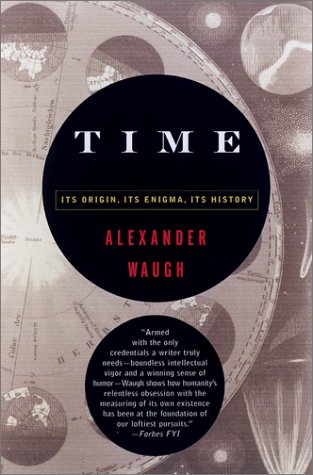As the book’s title has all the lyric delicacy of a Rolex advertising campaign, and as we quickly discover that its author is neither a philosopher nor a watchmaker, it becomes clear at the outset that what we are up against is the most irritating of genres, popular science. In Mr. Waugh’s defense, I hasten to add that, for us laymen, one of the most infuriating aspects of the did-you-know approach he plies here is that too often our answer is a grudging “No.” The result is that the untutored reader, who has every right to consider himself the untutored writer’s equal, finds himself learning things against his own better judgment. This is almost as humiliating as listening to your dentist talk about Baudelaire.
On the whole, it may be well worth the unpleasantness, however embarrassing it is, to hear Mr. Waugh (grandson of Evelyn, son of Auberon) pal around with his crimson-faced audience throughout what is undeniably an ill-composed, messy, and repetitive compendium of facts, conjectures, and ideas. Perhaps that is because this reviewer, in particular, has a weakness for Mr. Waugh’s subject, and, seeing it twisted this way and that, as it is here, without any apparent purpose and in the absence of a cogent thesis, is easily and mightily pleased nonetheless. Perhaps if you really love Baudelaire you won’t mind hearing about him between rinses.
The lesson of Mr. Waugh’s untidy little book, for me at least, is this: Modern man, insofar as he is the avowed creature of scientific reason, inhabits a universe of numbers. The things he counts most assiduously are time and money. (Incidentally, I would not mind seeing a book that set out to relativize money even if it were written with the same coltish haphazardness with which Mr. Waugh tackles his subject in Time.) Of course, modern man’s rationality is all make-believe, and by far the greater part of his reckoning is as much the product of a cultural convention as crossword puzzles, pickling recipes, or Renaissance painting.
Tell the train conductor who’s checking your ticket to Naples that you’ve had a dream about your late grandfather, and he’ll tell you that you ought to play 47 in the weekly lottery because 47 is the number of a dead man talking. Yet the New York broker who advises you to get into e-stocks because e-commerce is the way of the future is hardly more rational, in any meaningful sense of the word, than the Neapolitan fantasist. It’s just that his vulgar tautology is couched in a more palatably modern way.
So it is with time. Its objectification, representation, and measurement is a cult activity of modern man, that deluded conformist who, instead of listening to church bells or observing the sunset, wears a personal wristwatch to proclaim his individualism. Like the impotent who gags at the idea of a love potion made from tiger guts and bat droppings but will happily take Viagra, modern man is discomfited at the suggestion that he ought to divide his life into the hours of crepusculum (of dusk), vesperum (of the evening star), intempestum (of the night), galicinium (of the crowing cock), and diluculum (of the dawn). He would hate to be reminded that the hour does not “have” 60 minutes in it, nor “are” there 60 seconds in a minute, but that these are mere social conveniences like proper spelling, acceptable table manners, or polite behavior at the theater. And he would be furious to hear that, while the earth does turn on its axis (however abstract this proposition) and goes around the sun (whatever that means), the cocksure confidence with which he—an irreligious and superstitious conformist, leading a vacuous yet rigidly regimented life—divides his days by 24 and his years by 365 is no more modern than the sense of collective security that fools have always found in all received wisdom. A good example of his fury, incidentally, are the popular riots that spread across Europe in the 1580’s, and England in the early 1750’s, at the introduction of the new Gregorian calendar, replacing the Julian calendar which had been in use since 45 B.C.
The list of such “relativizing” experiences is long and uncomfortable, culminating perhaps in Einstein’s theory of space-time, which
would allow for all times-past, present, and future—to coexist. That we can only see one plane in die time dimension, the present, is neither here nor there. When we look at a three-dimensional object—a cupboard, for instance—we cannot see all of its sides at once; nor would it be sensible to infer from our one angle of vision that the other sides of the cupboard do not exist. The same is the case for time.
This is almost a literal, word for word repetition of a memorable passage from a treatise on the philosophy of light in Russian icon painting written by Pavel Florensky in 1921, known as The Iconostasis. Before the introduction of perspective—itself a cultural convention rather like time—religious painting sought to represent its sacred subjects by means of light upon contiguous planes of time and space. And, of course, it is light that, according to Einstein, defines infinity.
In this sense, the lesson of Mr. Waugh’s book (though not a wholly intended one, I fear) is that, in the 21st century, not to believe in God and Creation is not only unscientific, it is provincial. The university-educated, well-traveled, news-paper-reading modern man, the Wall Street paterfamilias and culture vulture, proud of his gold watch and convinced that he is nobody’s fool because he can tell you the time, is less free, less cosmopolitan, and finally less rational than an illiterate peasant living in an obscure corner of medieval Europe.
At least the peasant had no delusions about what made him tick.
[Time: Its Origin, Its Enigma, Its History, by Alexander Waugh (New York: Carroll & Graf) 288 pp., $25.00]

Leave a Reply